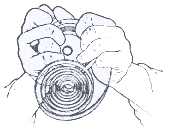| The thorough restoration
of an antique record player involves the
application of many sciences. For
example, the model B Edison standard
Phonograph requires knowledge in wood
cabinet repair and applying a finish
coating on wood and/or metal. It also
requires a knowledge of clockwork motors,
power main springs, acoustics, and a
familiarity with some machine tools. The
embodiment of all these worth-while
sciences is what makes vintage record
players such a valuable artifact, and the
hobby of collecting them so rewarding. |
 |
 |
My wife,
Patti, and I needed to know
something or know some- one who
knew something about each of
these different fields in order
to provide a complete supply
catalog for the restoration of
vintage mechanical record
players. Main spring production
requires understanding the
metallurgy of spring steel and
knowledge of how steel is
produced. This way, the original
tolerances can be achieved and
the correct part provided for the
best price. Mica production and
processing knowledge allows us to
produce the best diaphragm and to
recognize a faulty one. We share
our knowledge so that a conplete,
thorough, and effective
restoration can be accomplished.
This way, our products and the
antique phonograph are well
represented. |
|
Experience has become our most
valuable resource. Since we are working with used
equipment, which likely was stored for posterity
after it no longer functioned, it is important to
know when worn parts are usable or when they
should be replaced. The fact that a part is still
working is not proof that it should not be
replaced. Often a component is near break down or
not functioning well. We should know what good
quality repair parts are available and avoid
doing damage to components that would be
difficult and expensive to make.
The
antique restorer is faced with the unique
challenge of repairing a mechanical device with
an indefinite useful life expectancy.
Seventy-five years ago, a record player mechanic
would be correct when he patched up a Victor III
to run "well enough for now". His
client could be advised to save for a new style
Victrola and cut corners on the repair of the old
model. After all, by 1918 the case could be made
that Victrolas were improving remarkably over the
past few years. Today you have done a disservice
to an important artifact with any repair that
falls short of a thorough restoration. I would
like to advance this belief by sharing my
knowledge and experience with collectors.
-APSCO
Answer Man
| APSCO Answer man ? |
APSCO Answer man 1975 |
|

